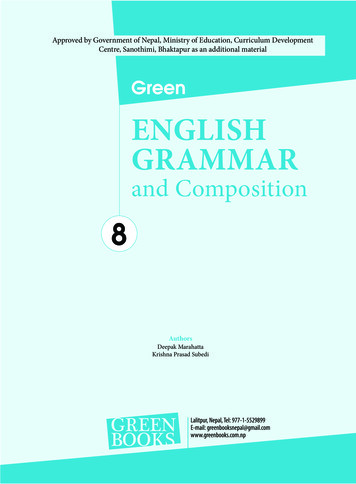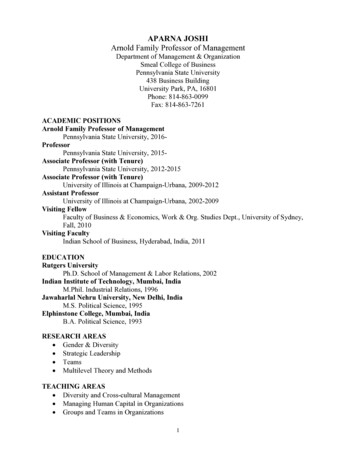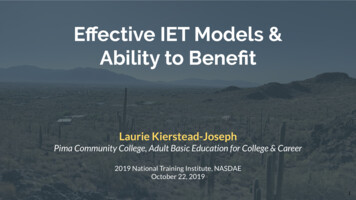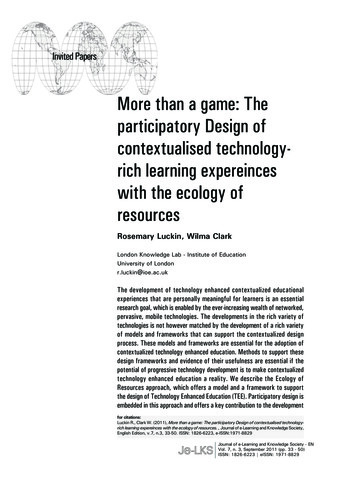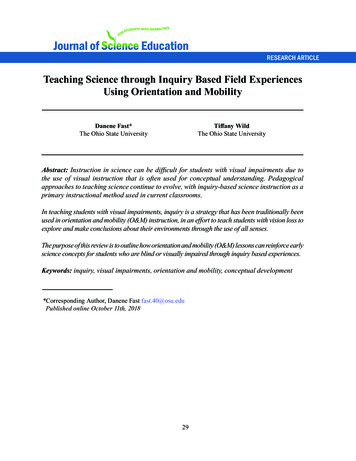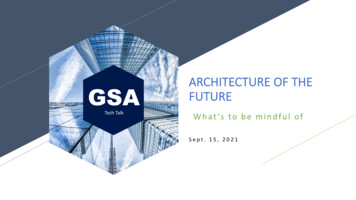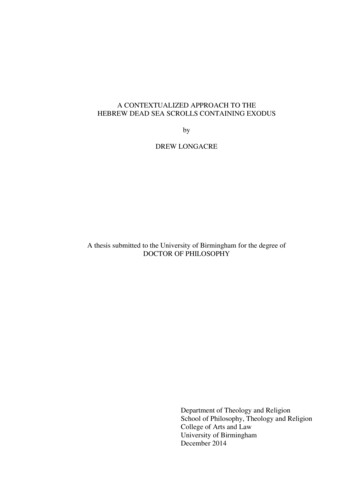
Transcription
A CONTEXTUALIZED APPROACH TO THEHEBREW DEAD SEA SCROLLS CONTAINING EXODUSbyDREW LONGACREA thesis submitted to the University of Birmingham for the degree ofDOCTOR OF PHILOSOPHYDepartment of Theology and ReligionSchool of Philosophy, Theology and ReligionCollege of Arts and LawUniversity of BirminghamDecember 2014
University of Birmingham Research Archivee-theses repositoryThis unpublished thesis/dissertation is copyright of the author and/or thirdparties. The intellectual property rights of the author or third parties in respectof this work are as defined by The Copyright Designs and Patents Act 1988 oras modified by any successor legislation.Any use made of information contained in this thesis/dissertation must be inaccordance with that legislation and must be properly acknowledged. Furtherdistribution or reproduction in any format is prohibited without the permissionof the copyright holder.
ABSTRACTThis thesis suggests a new approach to studying the Hebrew-language Dead Sea Scrolls(DSS) containing Exodus. After surveying the history of research, Longacre suggests applyinga contextualized approach to the study of these scrolls, which seeks to understand them first asindividual material artifacts and then in comparison to other manuscripts which are mostclosely contextually connected to them. Each manuscript is only subsequently compared withincreasingly contextually distant manuscripts according to a hierarchy of contextual proximity.A network of close contextual connections between the Hebrew DSS containingExodus warrant the isolation of this corpus as a test case for application of a contextualizedapproach. Based on new transcriptions and reconstructions of each of the included manuscripts(1Q2 2Q2 2Q3 2Q4 4Q1 4Q11 4Q13 4Q14 4Q17 4Q18 4Q19 4Q20 4Q21 4Q22 4Q158 4Q3644Q365 4Q366 Mur1), Longacre then analyzes patterns that emerge from a comparison of thecharacteristics of each of these manuscripts. Finally, from a close examination of textualoverlaps from a wide variety of qualitative and quantitative perspectives, Longacre suggestsseveral specific groups and clusters of texts and synthesizes them to provide clearer insight intothe documented Hebrew-language textual history of the book of Exodus.
To my dear wife, Michelle Longacre,without whose patience, love, and supportthis research would not have been possible. תנו לה מפרי ידיה ויהללוה בשערים מעשיה -Proverbs 31:31
ACKNOWLEDGEMENTSDespite the relief of completing the work, this doctoral thesis is not a finished line, butrather a milestone on a long journey on which I am already indebted to a great many. To allthose whose investments in me prepared me for this work, I am sincerely grateful for yourefforts. In particular, I would like to thank Steven Boyd for introducing me to the Hebrewlanguage, William Varner for introducing me to the world of textual criticism, and WilliamBarrick for showing me the need for the application of textual criticism to the Old Testament.I am also grateful for many who have directly or indirectly contributed to this research.Stefan Schorch, Nathan Jastram, and Kyungrae Kim all kindly sent me unpublished work forreference purposes. Hugh Houghton was kind enough to offer his advice during the course ofmy program and read a draft of chapter 4. The seminars of the Institute for Textual Scholarshipand Electronic Editing and the “Manuscripts and Their Texts” postgraduate seminars at theUniversity of Birmingham repeatedly challenged me to think methodologically about my ownresearch. Personal conversations with Eibert Tigchelaar and Sidnie White Crawford wereparticularly helpful for the study of the included manuscripts. Anneli Aejmelaeus, Hanne vonWeissenberg, and the other members of team 2 of the University of Helsinki’s Centre ofExcellence in Changes in Sacred Texts and Traditions also kindly interacted with the contentsof this thesis in a workshop which provided much useful feedback.Furthermore, this research would not have been possible without the generosity of theUniversity of Birmingham, who fully funded my program with a Doctoral Researcher EliteScholarship. Similarly, the University of Helsinki permitted me to finalize this thesis duringmy first months of postdoctoral research at the Centre of Excellence in Changes in Sacred Textsand Traditions.But perhaps most importantly, I would like to thank my supervisor Charlotte Hempelfor her support throughout this process. As all of her students are well aware, Charlotteconsistently goes above and beyond the call of duty as a supervisor. She invests herself fullyin both the personal welfare and development of her students and their research. Her insightfulcritiques have kept me from numerous errors and refined this research far beyond what it wouldhave been without her. Of course, any remaining errors or weaknesses are my own.On a more personal note, my wife Michelle and daughters Victoria and Gloria havebeen my constant companions in a seemingly unending series of studies that has taken adecidedly international turn. They have all sacrificed much for the sake of my research, andtheir support has been essential for its completion.And finally, thanks be to God, who has richly blessed us and faithfully led us throughmany life stages over the past few years. We have always had enough to meet our needs, andhis love continues to carry us through. May the contents of this thesis be profitable for hiskingdom. יהיו לרצון אמרי פי והגיון לבי לפניך יהוה צורי וגאלי -Psalm 19:15 [Eng. v. 14]
CONTENTSLIST OF FIGURESLIST OF TABLESLIST OF ABBREVIATIONSLIST OF TRANSCRIPTION SYMBOLSINTRODUCTION .1CHAPTER 1 – HISTORY OF RESEARCH ON THE SCRIPTURAL MANUSCRIPTSFROM THE JUDEAN DESERT AND THE TEXT OF EXODUS .21.1 Introduction . 21.2 Pre-Qumran Theories on the Textual History of the Pentateuch . 21.3 Post-Qumran General Discussions on the Textual History of the Pentateuch . 31.3.1 Local Texts . 51.3.2 Multiple Mixed Groups . 71.3.3 Variant Literary Editions . 121.3.4 Descriptive Categorization . 151.3.5 The Challenge of the 4Q(Reworked) Pentateuch Manuscripts . 171.3.6 The Question of the Original Text(s). 201.4 Post-Qumran Detailed Studies of the Text of Exodus . 241.4.1 Judith E. Sanderson . 241.4.2 Nathan Jastram . 331.4.3 Bénédicte Lemmelijn . 371.4.4 James R. Davila . 401.5 Conclusion . 41CHAPTER 2 – A CONTEXTUALIZED APPROACH TO THE SIGNIFICANCE OFANCIENT MANUSCRIPTS FOR TEXTUAL HISTORY .442.1 Introduction . 442.2 Individual Textual Artifacts . 462.2.1 Preliminaries to the Study of Fragmentary Manuscripts . 492.2.1.1 Collection, Identification, and Transcription of Fragments from the Manuscript. 492.2.1.2 Material Reconstruction . 502.2.1.3 Textual Reconstruction . 52
2.2.2 Bibliographical Analysis . 582.2.2.1 Provenance . 582.2.2.2 Manuscript Format . 592.2.2.3 Manuscript Contents . 602.2.2.4 Layout and Segmentation . 602.2.2.5 Paleography . 612.2.2.6 Paratextual Information. 632.2.3 Textual Analysis . 642.2.3.1 Language . 642.2.3.2 Orthography. 652.2.3.3 Errors and Corrections . 672.2.3.4 Miscellaneous Scribal Practices . 712.2.3.5 Analysis of Intrinsic Textual Evidence . 712.3 The Nature of Contextual Connectivity between Manuscripts . 732.3.1 Multiple Distinct Contextual Stages . 732.3.2 Multiple Distinct Contextual Factors. 742.3.2.1 Temporal Contexts. 752.3.2.2 Geographical Contexts . 762.3.2.3 Socio-Religious Contexts . 772.3.2.4 Literary Contexts . 782.3.3 Concentric Circles of Contextual Connectivity . 812.3.3.1 Immediate Context . 862.3.3.2 Near Context. 872.3.3.3 Far Context . 882.4 Comparative Analysis . 902.4.1 Description of Similarities and Differences . 912.4.2 Evaluation of Manuscript Relationships . 922.4.2.1 Connective Readings . 922.4.2.2 Statistical Clusters of Texts . 932.5 Reconstruction of Textual History . 932.5.1 Inductive Reconstruction of Textual History . 942.5.2 Iterative Refinement of Textual History and Analysis . 942.6 Conclusion . 97
CHAPTER 3 – PRIMARY EVIDENCE FOR THE TEXT OF EXODUS IN THE DEAD SEASCROLLS 993.1 Introduction . 993.2 Primary Evidence for the Text of Exodus in the DSS Utilized for This Study . 1003.2.1 1Q2 – 1QExod . 1013.2.2 2Q2 – 2QExoda. 1023.2.3 2Q3 – 2QExodb . 1033.2.4 2Q4 – 2QExodc. 1063.2.5 4Q1 – 4QGen-Exoda . 1073.2.6 4Q11 – 4QpaleoGen-Exodl . 1083.2.7 4Q13 – 4Q[Gen]-Exodb . 1093.2.8 4Q14 – 4Q[Gen]-Exodc . 1103.2.9 4Q17 – 4QExod-Levf . 1113.2.10 4Q18 – 4QExodg. 1123.2.11 4Q19 – 4QExodh. 1133.2.12 4Q20 – 4QExodj . 1133.2.13 4Q21 – 4QExodk. 1143.2.14 4Q22 – 4QpaleoExodm. 1143.2.15 4Q158 – 4Q(Reworked) Pentateucha . 1193.2.16 4Q364 – 4Q(Reworked) Pentateuchb. 1203.2.17 4Q365 – 4Q(Reworked) Pentateuchc . 1213.2.18 4Q366 – 4Q(Reworked) Pentateuchd. 1243.2.19 Mur1 – MurGen-Exod, Numa. 1263.3 Other Major Textual Traditions Utilized for This Study. 1273.3.1 Masoretic Text (M) . 1283.3.2 Samaritan Pentateuch (S) . 1293.4 Textual Witnesses Not Systematically Integrated into This Study . 1293.4.1 Non-Hebrew Texts . 1303.4.2 Excerpted Texts . 1333.4.3 Obvious Exodus Hypertexts . 1353.4.4 Commentaries. 1383.4.5 Citations and Allusions in Free Compositions . 1383.5 Conclusion . 139
CHAPTER 4 – A CONTEXTUALIZED APPROACH TO THE HEBREW DEAD SEASCROLLS CONTAINING EXODUS . .1414.1 Introduction . 1414.2 Contextual Connections of the DSS Containing the Text of Exodus . 1414.2.1 Temporal Connections . 1424.2.1.1 Temporal Inscription Contexts . 1424.2.1.2 Temporal Lived Contexts . 1434.2.2 Geographical Connections . 1444.2.2.1 Geographical Inscription Contexts . 1444.2.2.2 Geographical Lived Contexts . 1454.2.3 Socio-Religious Connections . 1454.2.3.1 Socio-Religious Inscription Contexts . 1454.2.3.2 Socio-Religious Lived Contexts . 1474.2.4 Literary Connections . 1484.2.4.1 Language and Content . 1484.2.4.2 Pentateuchal Context . 1484.2.4.3 Scriptural Status . 1534.2.5 Contextual Connectivity of the Hebrew DSS Containing Exodus . 1534.3 Differences in Hebrew DSS Containing Exodus . 1544.3.1 Descriptive List of Differences . 1554.3.1.1 Alternative Readings . 1554.3.1.2 Small Pluses/Minuses . 1564.3.1.3 Large Pluses/Minuses . 1564.3.1.4 Small Sequence Differences . 1574.3.1.5 Large Sequence Differences . 1574.3.2 Scribal Errors. 1584.3.2.1 Orthographic Errors . 1604.3.2.2 Substitutions . 1624.3.2.3 Omissions . 1644.3.2.4 Additions . 1654.3.2.5 Transpositions . 1664.3.3 Singular Readings . 1674.3.3.1 Methodology. 1674.3.3.2 Data Set . 1704.3.3.3 Percentage Singular Readings . 171
4.3.3.4 Conservative vs. Interventionist Approaches . 1734.3.4 Editorial Interventions . 1764.3.4.1 Harmonization . 1774.3.4.2 Exegetical Expansion . 1854.3.4.3 Grammatical Agreement . 1874.3.4.4 Morphological Disambiguation . 1884.3.4.5 Literalization of Language . 1884.3.4.6 Generalization of Legal Material . 1904.3.4.7 Emendations of Corrupted Text . 1914.3.4.8 Ideological Change . 1914.3.4.9 Rearrangement . 1924.3.4.10 Paraphrase? . 1934.3.5 “Synonymous” Readings?. 1944.4 Towards a Textual History of the Book of Exodus . 1954.4.1 Literary Identity and Nature of the Book of Exodus . 1954.4.1.1 Distinct Supercluster of Texts . 1954.4.1.2 Definite Contents, Structure, and Text with Limited Internal Variation . 2034.4.1.3 Pentateuchal Context . 2044.4.2 Grouping Manuscripts . 2054.4.2.1 Connective Readings . 2064.4.2.2 Statistical Patterns of Agreement and Disagreement . 2094.4.2.3 Reconciling Approaches . 2144.4.3 Textual Groups and Clusters . 2154.4.3.1-Group (4Q158 4Q364 4Q365 4Q366?) . 2164.4.3.2 -Group (4Q22 S) . 2204.4.3.3-Group (4Q22 4Q158 4Q364 4Q365 4Q366? S). 2204.4.3.4-Group (4Q17 4Q20 4Q22 4Q158 4Q364 4Q365 4Q366? S) . 2214.4.3.5 -Group (4Q11 4Q14) . 2234.4.3.6-Group (4Q11 4Q14 4Q17 4Q20 4Q22 4Q158 4Q364 4Q365 4Q366? S) 2244.4.3.7-Cluster (1Q2 4Q1 4Q11 4Q18 Mur1 M) . 2254.4.3.8 Septuagint-Like Texts? . 2284.4.4 Stemmatology in Exodus . 2294.4.4.1 Common Descent from a Single, Written, Predominant Ancestor? . 2294.4.4.2 Textual Mixture? . 2364.4.4.3 Standardization? . 241
4.4.4.4 Multiple Emergence of Variant Readings . 2444.4.4.5 Scribal Emendations? . 2454.4.4.6 Fragmentary Evidence . 2464.4.4.7 Conservative Evidence . 2484.4.4.8 The Viability and Value of Stemmatology for the Hebrew DSS ContainingExodus . 2494.4.5 Reconstruction of the Documented Hebrew-Language Textual History of Exodus. 2504.4.6 Iterative Relationship between Textual History and Evaluation of Variation-Units. 2514.5 Conclusion . 252CONCLUSION .254APPENDICES. .256A.1 Glossary of Technical Terminology Defined in This Thesis . 256A.2 Contents of Hebrew DSS Containing Exodus . 259A.3 Pre-Genealogical Coherence Charts . 267A.4 List of Variation-Units and Variant Readings . 278REFERENCES. .293
LIST OF FIGURESFigure 2.1 – Concentric Hierarchy of Contextual Proximity to the FM .90Figure 4.1 – Manuscript Type by Century .152Figure 4.2 – Manuscript Type by Cave .153Figure 4.3 – Clustered Spectrum of Percentage Singular Readings per Manuscript .172Figure 4.4 – Types of Singular Readings for High- and Low-Percentage-Singular Manuscripts 173Figure 4.5 – Connectivity Web of Manuscripts Overlapping for 49 Words . .198Figure 4.6 – Connectivity Web of DSS Overlapping for 49 Words .199Figure 4.7 – Connectivity Web of DSS Overlapping for 4 Words .201Figure 4.8 – SplitsTree4 Diagrams with and without a Minimum Number of PreservedReadings 214Figure 4.9 – Illustration of -Group .224Figure 4.10 – Connectivity Web for -Cluster .225Figure 4.11 – Illustration of -Cluster 227Figure 4.12 – Reconstruction of Textual History .250
LIST OF TABLESTable 1.1 – Percentage of Manuscripts per Textual Category according to Tov .9Table 4.1 – Chronological Spread of Hebrew DSS Containing Exodus 142Table 4.2 – Preserved Book Contents of Multi-Work Manuscripts (Shaded) .149Table 4.3 – Bibliographical Classification of the Hebrew DSS Containing Exodus .151Table 4.4 – Percentage Scribal Errors in Manuscripts .159Table 4.5 – Clear Scribal Errors per Manuscript by Type of Variation-Unit 160Table 4.6 – Scribal Errors of Orthography .161Table 4.7 – Scribal Errors of Substitution .163Table 4.8 – Scribal Errors of Omission .165Table 4.9 – Scribal Errors of Addition .166Table 4.10 – Singular Readings Excluding M S 168Table 4.11 – Singular Readings per Manuscript by Type of Variation-Unit Including M S.171Table 4.12 – Percentage Singular Readings per Manuscript .172Table 4.13 – Harmonizations in the Lists of Nations 179Table 4.14 – Harmonizations with Exodus Material .184Table 4.15 – Harmonizations with Non-Exodus Material .184Table 4.16 – Small Exegetical Expansions 186Table 4.17 – Large Exegetical Expansions 187Table 4.18 – Changes in Grammatical Number .188Table 4.19 – Generalizations of Legal Material 190Table 4.20 – Ranges of Percentage Agreement between Overlapping Parts of Manuscripts.197Table 4.21 – Agreements/Disagreements in Collated Variant Readings between Manuscripts. 213Table 4.22 – Incompatible Sets of Readings .239
LIST OF ABBREVIATIONSBJSBrown Judaic StudiesDeutDeuteronomyDJDDiscoveries in the Judaean Desert (principle edition series)DSSDead Sea Scroll(s)ExodExodusFMFocal manuscript (see section 2.2)Frg(s).Fragment(s)FRLANT Forschungen zur Religion und Literatur des Alten und Neuen TestamentsGSeptuagintGenGenesisHSSHarvard Semitic StudiesJSJSupSupplements to the Journal for the Study of JudaismLevLeviticusMMasoretic text (see section 3.3.1)NTNew TestamentNTSupSupplements to Novum TestamentumNTTSDNew Testament Tools, Studies, and DocumentsNumNumbersOTOld Testament (Protestant, unless otherwise defined)OTSOudtestamentische StudiënPAMPalestine Archaeological Museum (photograph series)QSPQumran Scribal Practice(R)P(Reworked) Pentateuch (see section 1.3.5)SSamaritan Pentateuch (see section 3.3.2)SBLTCS Society of Biblical Literature Text-Critical StudiesSTDJStudies on the Texts of the Desert of JudahTSAJTexts and Studies in Ancient JudaismVTSupSupplements to Vetus TestamentumWUNT I Wissenschaftliche Untersuchung zum Neuen Testament
LIST OF TRANSCRIPTION SYMBOLS Circles to indicate ink traces of unknown identification. ̊ב Combining rings above to indicate possible identifications. ב Combining dots above to indicate very probable identifications. Sometimes alsocombining dots above and below to indicate erasure dots in corrections.{ }ב Curly brackets to indicate erased text.[ ]ב Square brackets to indicate the extent of preserved parchment when necessary.Text within square brackets is, therefore, reconstructed. ב Gray text to indicate reconstructed text.
INTRODUCTIONTextual history is currently one of the most contentious questions facing scholars whostudy the text of the Hebrew Bible/Old Testament (OT). In this discussion, we see afragmentation of numerous personalized views of how the history of our texts should beconceptualized. In this thesis, I would like to point towards a possible way out of this confusedstate and demonstrate its potential value on a select corpus.As a test case for the methodology proposed in this thesis, I hav
HEBREW DEAD SEA SCROLLS CONTAINING EXODUS by DREW LONGACRE A thesis submitted to the University of Birmingham for the degree of DOCTOR OF PHILOSOPHY Department of Theology and Religion School of Philosophy, Theology and Religion College of Arts and Law University of Birmingham December 2014



